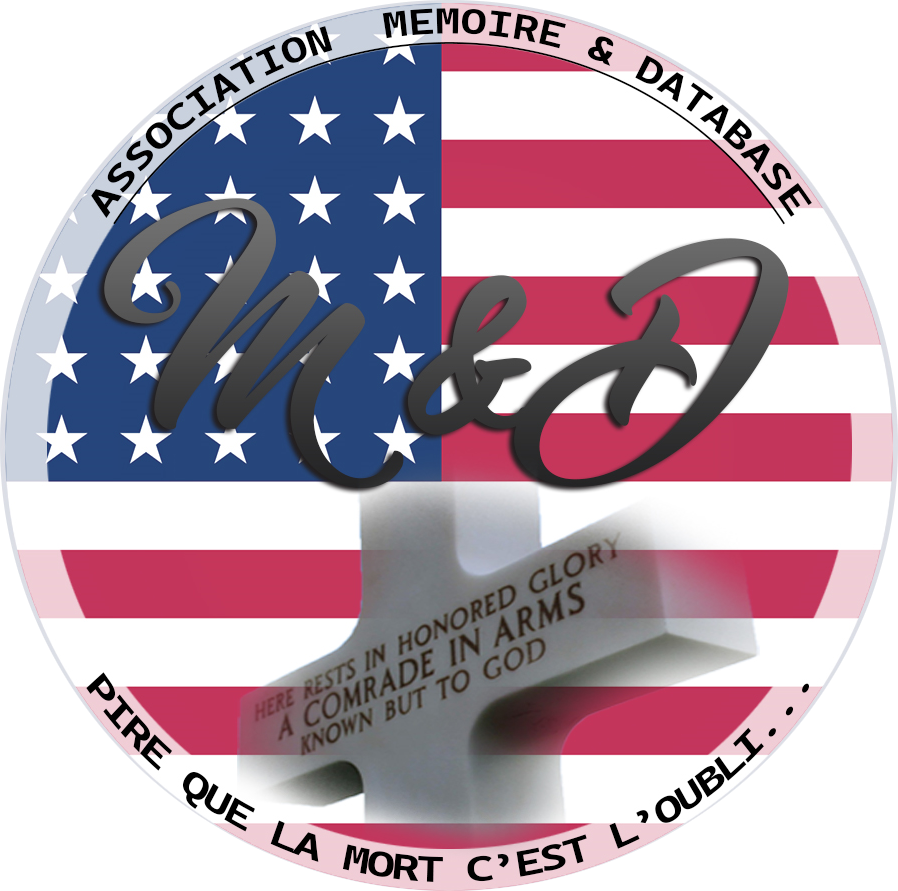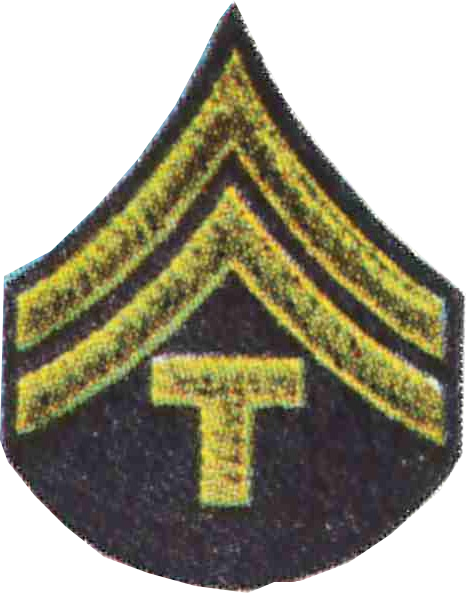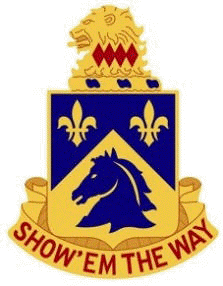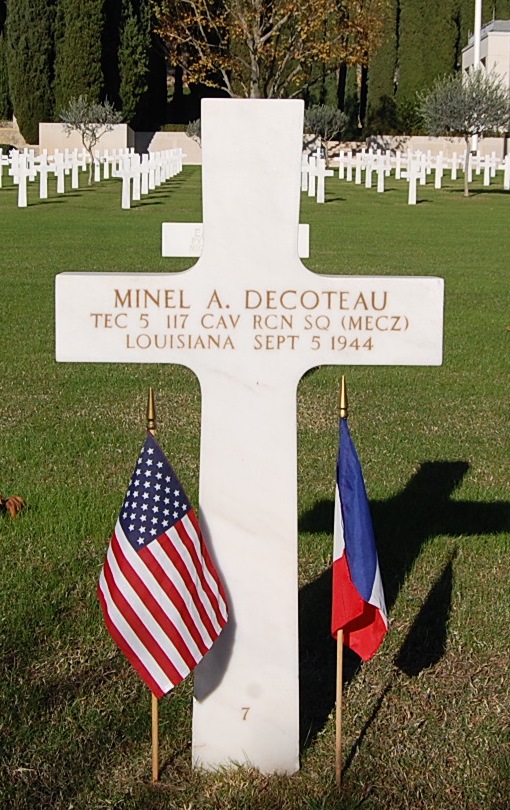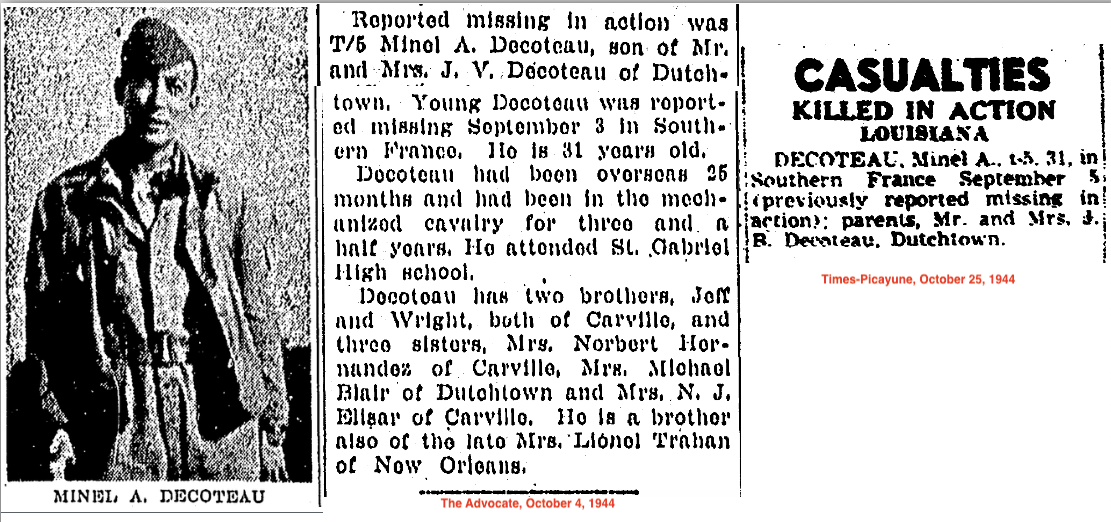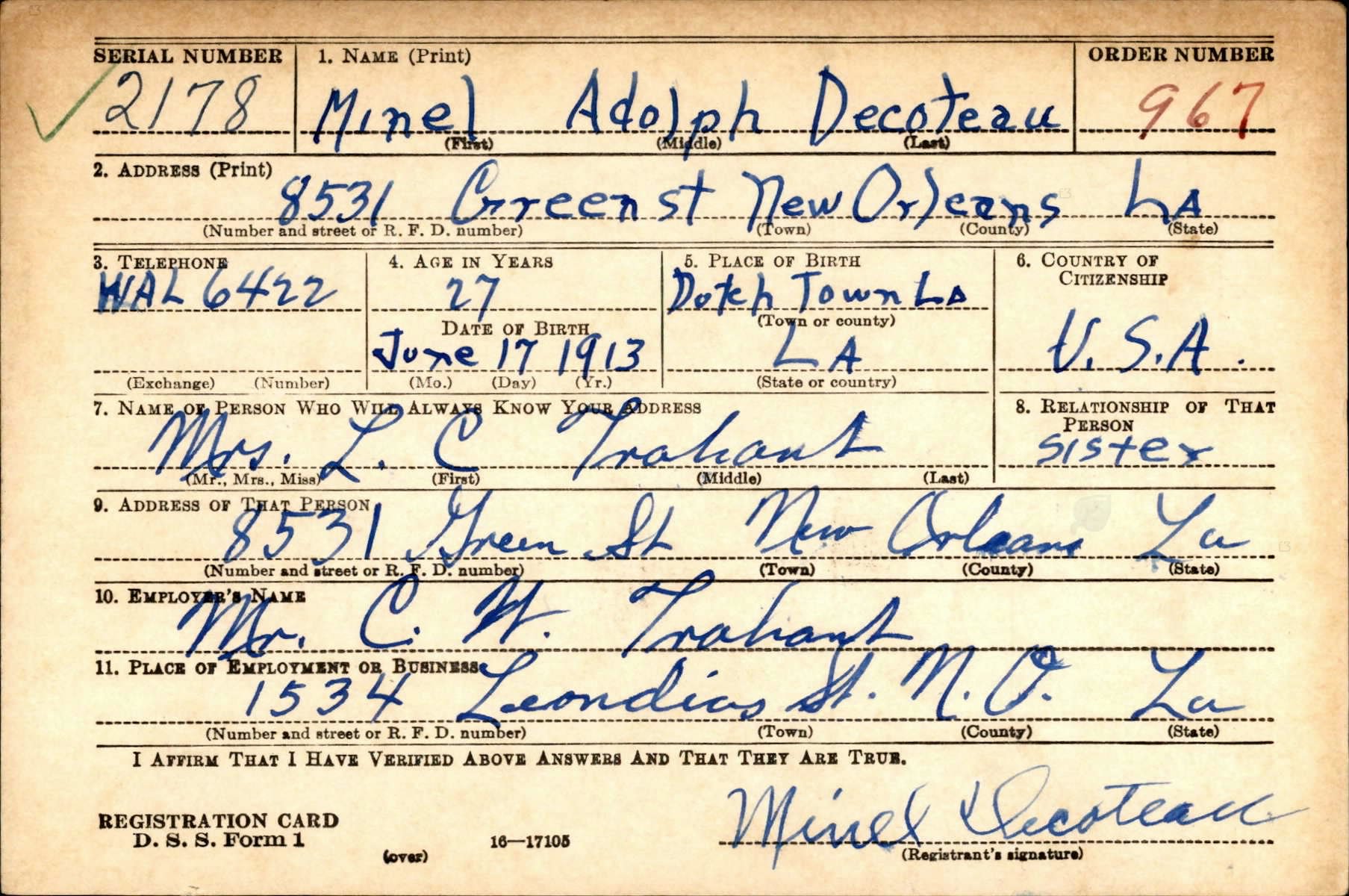|
Minel Adolphe DECOTEAU
| |||||||
|---|---|---|---|---|---|---|---|
|
Source : Jean-Marie Gillet (Ellen Marchese)
| |||||||
| NUMBER OF SERVICE | 34078543 | ||||||
| AGE | 31 yo | ||||||
| DATE OF BIRTH | 17 June 1913 Dutch Town, Ascension Parish, LOUISIANA | ||||||
| ENLISTMENT STATE | LOUISIANA | ||||||
| FAMILY |
Parents : Jean-Baptiste & Lena DECOTEAU Brothers : Zepherin & Wright Sisters : Frances, Noella & Ruth | ||||||
| RANK |
| ||||||
| FONCTION | Crewman | ||||||
| JOB BEFORE ENLISTEMENT |  | ||||||
| DATE of ENLISTEMENT | |||||||
| SQUADRON | 117th Cavalry Reconnaissance Squadron | ||||||
| ARMY | 7th US Army | ||||||
| DATE OF DEATH | 5 September 1944 | 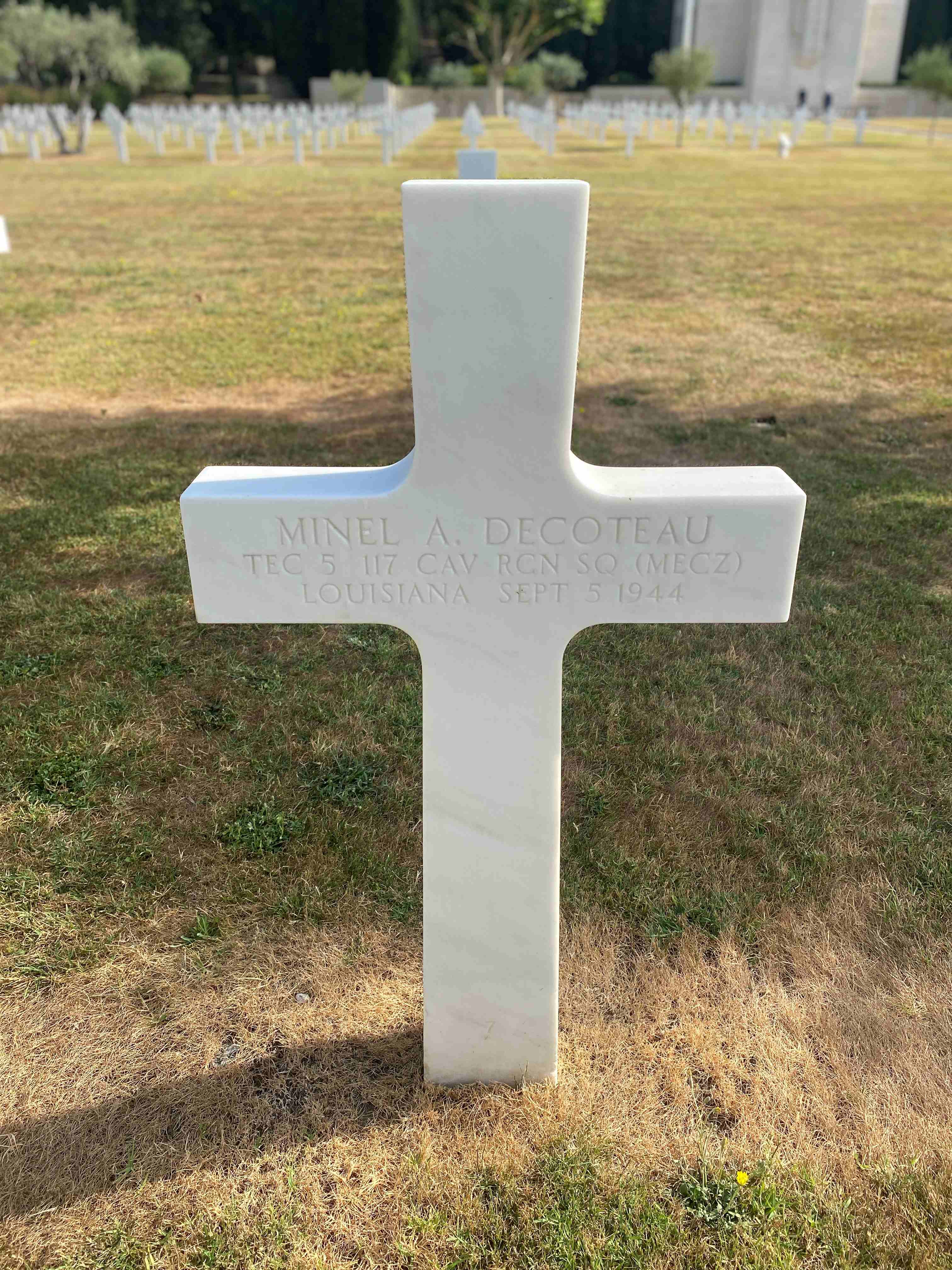 | |||||
| STATUS | KIA | ||||||
| PLACE OF DEATH | Sector of Saint-Vith & Besançon, DOUBS | ||||||
| DATA PLAN | Prisoner of War: September 3rd, 1944, Montrevel, Ain | ||||||
| CEMETERY TEMPORARY |
CEMTERY TEMPORARY of Draguignan N°3519 | ||||||
| CEMETERY | RHONE AMERICAN CEMETERY and MEMORIAL of Draguignan | ||||||
| GRAVE |
| ||||||
| DECORATION |
| ||||||
| |||||||
| STORY | |||||||
|
Source : Angy
|
Source : Family Graves 1.0 | ||||||
|
Source : Fold3 | |||||||
|
Contributor: Jean Marie Gillet Entered the service from Louisiana. Killed in action in southern France Prisoner of War: September 3rd, 1944, Montrevel, Ain (France). Missing in Action: September 4th, 1944 after the Battle of Montrevel, Ain, (France). Killed in Action: September 5th, 1944, area of Saint-Vith & Besançon, Doubs (France) when the prison convoy was attacked by P47 Republic thunderbolt of U.S. Air Force. In the confusion many men succeeded in escaping. Unfortunately Minel Decoteau was killed. Buried temporary in Cemetary #3519, Block : E, Row : 51, Grave : 602.
Statement of (then) Platoon Sergeant Ed Leonard, Troop B, 3rd Platoon In foggy conditions, we arrived at Montrevel earlier than 0530, my guess - 0400 hours. LT Bill Lutye and I were the first in; it was still dark. Our platoon immediately captured about a company of Germans who were sleeping on the ground floor of the municipal building, rifles neatly stacked. We were elated. We did not, at this time, know the scope of our mission. I left with orders from LT Lutye to position my mortar team and dismounted outposts on our left flank. On the way out I saw two men sleeping in the grass. I awakened them (roughly) and chewed them a little. I noticed then that one of them was young LT Daniel Lee (I still feel I owed him an apology - the way he performed later that day). I returned to our CP for further orders. Shortly after daybreak, the action started. German heavy tanks began shelling our supply vehicles, which were strung out to our rear. The rounds were coming from our left flank. It was flat trajectory, cannon fire. There were no misses. The ammo truck first and then the gas truck blew up spectacularly. A short time later a German light tank started around the corner of the crossroad. When this target appeared, about a dozen of our LMG's fired at him simultaneously. He backed up, out of sight. At the time, the Germans were impressed with our firepower. They estimated that we were a battalion. (My captors told me this the next day, while traveling north.) They trained their guns on the crossroad. About six men and I supported them on the ground. We positioned ourselves alongside and to the rear of the AC. At this time, there was sporadic gunfire on the perimeters. I assumed Mitchell was on the right flank with members of the 1st Platoon. I knew LT Padraig O'Dea and LT Lee had a force on the left flank. By now we realized that, we, one troop of lightly armed Cavalry, (150 men) were up against the seasoned 11th Panzer Division - 6,000 men equipped with heavy armor, heavy weapons and a battalion of attached infantry. We had grabbed a tiger by the tail. What do we do now? We had heard that one of our light tanks (M5A1) and/or one of our 105 Howitzers (M-7 HMC Priest) had reached a position on the main road, north of us, and was knocked out by German tank fire. We couldn't go back and we couldn't go forward onto the main road. Sometime later, from my position on the ground, I saw a German light tank. It was about 1/2 mile away, west of us, on the small road we were sitting on. It was barreling down the slope directly toward us. Schmetzer and Renzi saw it too. Renzi's first shot with the 37MM jolted it - his second stopped it, with its cannon and turret askew. Two direct hits - what a dead eye! After a brief respite, we spied an object moving out from the corner of the crossroad. As it slowly inched out, we realized it was a big muzzle brake - mounted on a very large cannon, which was mounted, we were sure, on a large tank or tank destroyer. As it inched slowly forward the track and then a bogey wheel came into view - Renzi fired. The track was severed at the top. The track fell down and lay out in front of the tank. The tank's forward movement stopped. Now it slowly inched back. We knew it could only go back the length of the ruptured track - so it had to be right there, just around the corner. The six feet of severed track was now the only thing visible. The next big event at the CP position happened when the Germans got their big guns on the high ground to the west. They had, evidently, managed a covered approach and we didn't know they were in position until the first round hit the municipal building, about 20 ft. off the ground. Now, all they had to do was lower their sights a little and we'd all be chopped meat. It was then that our officers sent one of our German prisoners to arrange our surrender. There were times during that day when I cursed the author of our "mission impossible", but we had held them at bay for about 11 hrs. Montrevel was gloriously liberated for those 11 hours. I wish we could have done more! The next day the Germans lined us up in front of the barn we had slept in. Then they brought up 3 big tanks, their weapons pointed at us. We were sure it was adios - but they only wanted us to witness the ceremonial burial of their young officer who died in the light tank that Renzi and Schmetzer had kayoed. I heard that POW Decoteau was killed en route to Germany by strafing American planes. | |||||||
| SOURCE INFORMATION & SOURCE PHOTO | Victor Daniel - Findagrave.com - Abmc.gov - Fold 3 |
|---|---|
| PROGRAMMER | Eric, Henri, Garrett, Clive, Frédéric & Renaud |


